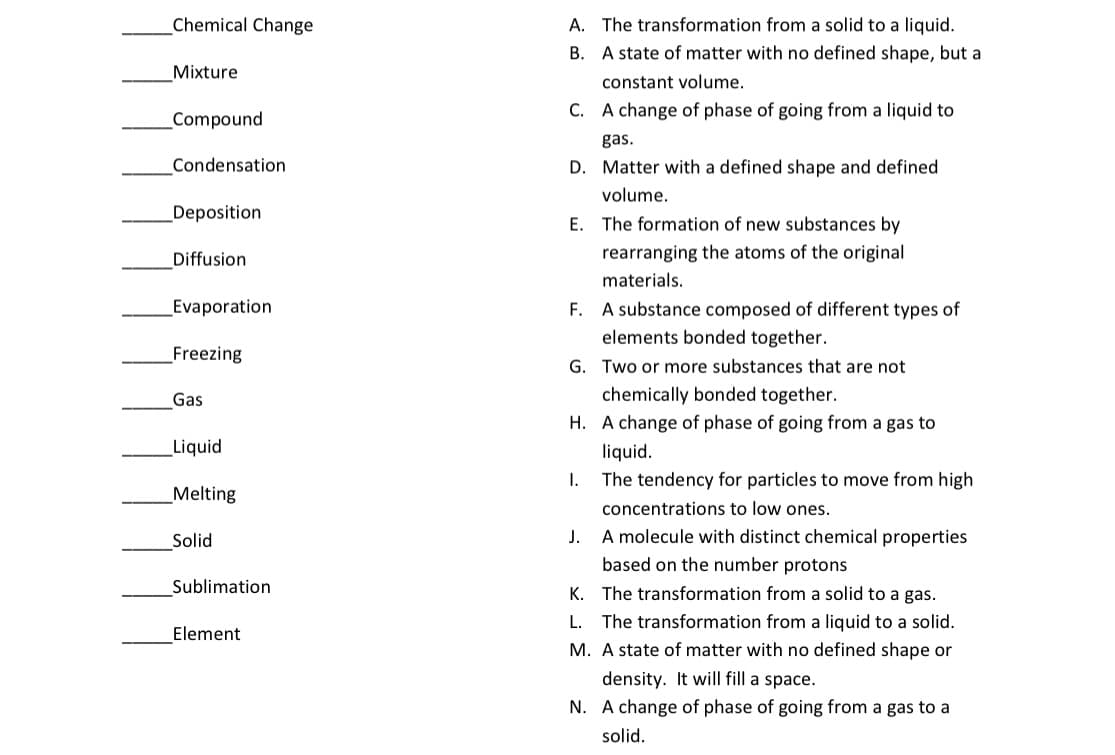gas. D. Matter with a defined shape and defined volume. E. The formation of new substances by rearranging the atoms of the original materials. F. A substance composed of different types of elements bonded together. G. Two or more substances that are not chemically bonded together. H. A change of phase of going from a gas to liquid. I. The tendency for particles to move from high concentrations to low ones. J. A molecule with distinct chemical properties based on the number protons K. The transformation from a solid to a gas. L. The transformation from a liquid to a solid. M. A state of matter with no defined shape or density. It will fill a space. N. A change of phase of going from a gas to a solid.
gas. D. Matter with a defined shape and defined volume. E. The formation of new substances by rearranging the atoms of the original materials. F. A substance composed of different types of elements bonded together. G. Two or more substances that are not chemically bonded together. H. A change of phase of going from a gas to liquid. I. The tendency for particles to move from high concentrations to low ones. J. A molecule with distinct chemical properties based on the number protons K. The transformation from a solid to a gas. L. The transformation from a liquid to a solid. M. A state of matter with no defined shape or density. It will fill a space. N. A change of phase of going from a gas to a solid.
Chemistry by OpenStax (2015-05-04)
1st Edition
ISBN:9781938168390
Author:Klaus Theopold, Richard H Langley, Paul Flowers, William R. Robinson, Mark Blaser
Publisher:Klaus Theopold, Richard H Langley, Paul Flowers, William R. Robinson, Mark Blaser
Chapter10: Liquids And Solids
Section: Chapter Questions
Problem 6E: Open the PhET States of Matter Simulation (http://openstaxcollege.org/l/16phetvisual) to answer the...
Related questions
Question
Match the following in the picture ⬇️

Transcribed Image Text:Chemical Change
A. The transformation from a solid to a liquid.
B. A state of matter with no defined shape, but a
Mixture
constant volume.
C. A change of phase of going from a liquid to
Compound
gas.
Condensation
D. Matter with a defined shape and defined
volume.
Deposition
E. The formation of new substances by
Diffusion
rearranging the atoms of the original
materials.
Evaporation
F. A substance composed of different types of
elements bonded together.
Freezing
G. Two or more substances that are not
Gas
chemically bonded together.
H. A change of phase of going from a gas to
Liquid
liquid.
I.
The tendency for particles to move from high
Melting
concentrations to low ones.
Solid
J.
A molecule with distinct chemical properties
based on the number protons
Sublimation
K. The transformation from a solid to a gas.
L. The transformation from a liquid to a solid.
Element
M. A state of matter with no defined shape or
density. It will fill a space.
N. A change of phase of going from a gas to a
solid.
Expert Solution
This question has been solved!
Explore an expertly crafted, step-by-step solution for a thorough understanding of key concepts.
Step by step
Solved in 2 steps with 1 images

Knowledge Booster
Learn more about
Need a deep-dive on the concept behind this application? Look no further. Learn more about this topic, chemistry and related others by exploring similar questions and additional content below.Recommended textbooks for you

Chemistry by OpenStax (2015-05-04)
Chemistry
ISBN:
9781938168390
Author:
Klaus Theopold, Richard H Langley, Paul Flowers, William R. Robinson, Mark Blaser
Publisher:
OpenStax

Chemical Principles in the Laboratory
Chemistry
ISBN:
9781305264434
Author:
Emil Slowinski, Wayne C. Wolsey, Robert Rossi
Publisher:
Brooks Cole

Chemistry & Chemical Reactivity
Chemistry
ISBN:
9781337399074
Author:
John C. Kotz, Paul M. Treichel, John Townsend, David Treichel
Publisher:
Cengage Learning

Chemistry by OpenStax (2015-05-04)
Chemistry
ISBN:
9781938168390
Author:
Klaus Theopold, Richard H Langley, Paul Flowers, William R. Robinson, Mark Blaser
Publisher:
OpenStax

Chemical Principles in the Laboratory
Chemistry
ISBN:
9781305264434
Author:
Emil Slowinski, Wayne C. Wolsey, Robert Rossi
Publisher:
Brooks Cole

Chemistry & Chemical Reactivity
Chemistry
ISBN:
9781337399074
Author:
John C. Kotz, Paul M. Treichel, John Townsend, David Treichel
Publisher:
Cengage Learning

Chemistry & Chemical Reactivity
Chemistry
ISBN:
9781133949640
Author:
John C. Kotz, Paul M. Treichel, John Townsend, David Treichel
Publisher:
Cengage Learning

World of Chemistry, 3rd edition
Chemistry
ISBN:
9781133109655
Author:
Steven S. Zumdahl, Susan L. Zumdahl, Donald J. DeCoste
Publisher:
Brooks / Cole / Cengage Learning

Introductory Chemistry: A Foundation
Chemistry
ISBN:
9781337399425
Author:
Steven S. Zumdahl, Donald J. DeCoste
Publisher:
Cengage Learning